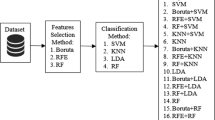Abstract
Kernel methods are often used for nonlinear regression and classification in statistics and machine learning because they are computationally cheap and accurate. The wavelet kernel functions based on wavelet analysis can efficiently approximate any nonlinear functions. In this article, we construct a novel wavelet kernel function in terms of random wavelet bases and define a linear vector space that captures nonlinear structures in reproducing kernel Hilbert spaces (RKHS). Based on the wavelet transform, the data are mapped into a low-dimensional randomized feature space and convert kernel function into operations of a linear machine. We then propose a new Bayesian approximate kernel model with the random wavelet expansion and use the Gibbs sampler to compute the model’s parameters. Finally, some simulation studies and two real datasets analyses are carried out to demonstrate that the proposed method displays good stability, prediction performance compared to some other existing methods.






Similar content being viewed by others
References
Albert JH, Chib S (1993) Bayesian analysis of binary and polychotomous response data. J Am Statist Assoc 88:669–679
Aronszajn N (1950) Theory of reproducing kernels. Trans Am Math Soc 58:337–404
Banerjee S, Carlin BP, Gelfand AE (2003) Hierarchical modeling and analysis for spatial data. Chapman and Hall/CRC
Băzăvan EG, Li F, Sminchisescu C (2012) Fourier kernel learning. In European Conference on Computer Vision, Springer, pp. 459-473
Bernardo JM, Degroot MH, Lindley DV (1985) Bayesian Statistics 2: Proceedings of the Second Valencia International Meeting. North-Holland, 2: 371-372
Bernardo JM, Smith AF (2009) Bayesian theory. John Wiley & Sons, vol. 405
Brown PJ, Fearn T, Vannucci M (2001) Bayesian wavelet regression on curves with application to a spectroscopic calibration problem. J Am Statist Assoc 96:398–408
Chakraborty S (2009) Bayesian binary kernel probit model for microarray based cancer classification and gene selection. Comput Stat Data Anal 53:4198–4209
Chakraborty S, Ghosh M, Mallick BK (2012) Bayesian nonlinear regression for large \(p\) small \(n\) problems. J Multiv Anal 108:28–40
Crawford L, Wood KC, Zhou X, Mukherjee S (2018) Bayesian approximate kernel regression with variable selection. J Am Stat Assoc 113:1710–1721
DeCoste D, Mazzoni D (2003) Fast query-optimized kernel machine classification via incremental approximate nearest support vectors. In IEEE International Conference on Machine Learning (ICML), pp. 115-122
Hastie T, Tibshirani R, Friedman J (2009) The elements of statistical learning. Springer, Second edition
Lynch SM (2007) Introduction to applied Bayesian statistics and estimation for social scientists. Springer Science & Business Media
Mallick BK, Ghosh D, Ghosh M (2005) Bayesian classification of tumours by using gene expression data. J Royal Stat Soc Series B (Statistical Methodology) 67:219–234
Noble WS (2006) What is a support vector machine? Nat Biotechnol 24:1565–1567
Rahimi A, Recht B (2007) Random features for large-scale kernel machines. In Advances in Neural Information Processing Systems (NIPS), pp. 1177-1184
Schölkopf B, Herbrich R, Smola AJ (2001) A generalized representer theorem. In International Conference on Computational Learning Theory, Springer, pp. 416-426
Shyu H, Sun Y (2002) Construction of a morlet wavelet power spectrum. Multidimens Syst Signal Process 13:101–111
Sifuzzaman M, Islam MR, Ali M (2009) Application of wavelet transform and its advantages compared to fourier transform. J Phys Sci 13:121–134
Vapnik VN (1999) An overview of statistical learning theory. IEEE Trans Neural Netw 10:988–999
Vapnik VN (2013) The nature of statistical learning theory. Springer Science & Business Media
Wahba G (1990) Spline models for observational data. SIAM, Philadelphia
Wang F, Du T (2000) Using principal component analysis in process performance for multivariate data. Omega 28:185–194
West M, Blanchette C, Dressman H, Huang E, Ishida S, Spang R, Zuzan H, Olson JA, Marks JR, Nevins JR (2001) Predicting the clinical status of human breast cancer by using gene expression profiles. Proc Nat Acad Sci 98:11462–11467
Zhang L, Zhou W, Jiao L (2004) Wavelet support vector machine. IEEE Trans Syst Man Cybern Part B (Cybernetics) 34:34–39
Zhang N, Ding S (2017) Unsupervised and semi-supervised extreme learning machine with wavelet kernel for high dimensional data. Memetic Comput 9:129–139
Zhang Z, Dai G, Jordan MI (2011) Bayesian generalized kernel mixed models. J Mach Learn Res 12:111–139
Acknowledgements
Bei Jiang and Linglong Kong were partially supported by grants from the Canada CIFAR AI Chairs program, the Alberta Machine Intelligence Institute (AMII), and Natural Sciences and Engineering Council of Canada (NSERC), and Linglong Kong was also partially supported by grants from the Canada Research Chair program from NSERC. Yaozhong Hu was supported by the NSERC discovery fund and a centennial fund of the University of Alberta. The authors would like to thank the Editor, the Associate Editor and the two anonymous referees for the critical comments and constructive suggestions which have led to the improvement of this article.
Author information
Authors and Affiliations
Corresponding author
Additional information
Publisher's Note
Springer Nature remains neutral with regard to jurisdictional claims in published maps and institutional affiliations.
Rights and permissions
Springer Nature or its licensor (e.g. a society or other partner) holds exclusive rights to this article under a publishing agreement with the author(s) or other rightsholder(s); author self-archiving of the accepted manuscript version of this article is solely governed by the terms of such publishing agreement and applicable law.
About this article
Cite this article
Guo, W., Zhang, X., Jiang, B. et al. Wavelet-based Bayesian approximate kernel method for high-dimensional data analysis. Comput Stat (2023). https://doi.org/10.1007/s00180-023-01438-1
Received:
Accepted:
Published:
DOI: https://doi.org/10.1007/s00180-023-01438-1




